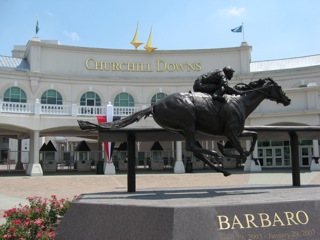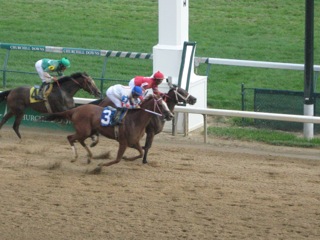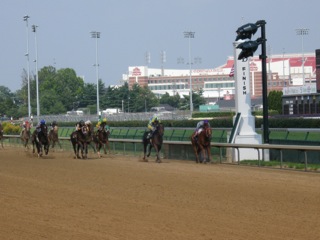JOURNEY TO MID-AMERICA AND ONTARIO - PART 2
By Jack M. Turner
Photos By John C. Turner
In Part 1 we visited several cities in the southeastern
and midwestern United States, rode two Amtrak routes, including our next
to last missing Amtrak line, and journeyed aboard two commuter lines during
the first half of our summer 2010 travels.
Along Lake Superior to White River
After complimentary continental breakfast at the
Lake View Hotel we crossed the street and boarded the 9:30am Star Line
ferry bound for Mackinaw City. Star Line operates ferry service every
half hour during summer daylight hours with a total of over 60 daily trips
linking Mackinac Island with Mackinaw City and St. Ignace. Within
minutes of landing at Mackinaw City we had loaded our overnight bags into
our van and were on our way northward.
(Click any photo below for a double-sized copy;
Click BACK in your browser to return to this page.)
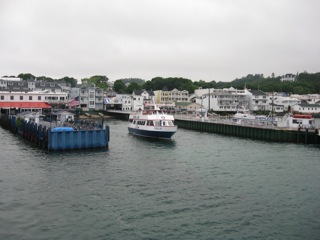
Departing Mackinac Island on a Star Line ferry
|
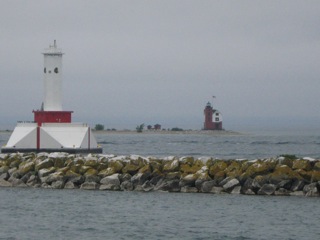
Lighthouses protect the entrance to the harbor at Mackinac Island
|
The towering Mackinac Bridge opened on November
1, 1957 to connect Michigan's upper and lower peninsulas. Today the
Mackinac Bridge is the longest suspension bridge in the western hemisphere
and third longest in the world. At its midpoint the deck of the
bridge stands 200 feet above the Straits of Mackinac which connect Lake
Michigan with Lake Huron. As part of Interstate 75, the bridge is
very busy due to its direct north-south route between the United States
and Canada.
|
Crossing the Mackinac Bridge high above the Straits
of Mackinac
|
About an hour north of the Mackinac Bridge we crossed
into Canada at Sault Ste. Marie where another bridge crosses the St. Marys
River and the locks serving oceangoing ships. This waterway connects
Lake Huron and Lake Superior via a network of lakes and bays. Due
to the heavy traffic using the I-75 routing, passage through Canadian Customs
took over 30 minutes. We took some time at Sault Ste. Marie to visit
the Algoma Central station where John and I would board a train in two
days then stopped at the visitor information center to get our bearings.
Highway 17, part of the Trans-Canada Highway, traced
the shore of Lake Superior and its many smaller inlets and bays as we
headed in a northerly direction. This route is one of the most scenic
in eastern North America as the highway's many twists and turns mixed with
hilly sections provide beautiful vistas of Lake Superior's blue waters.
Along the way there are numerous places to pull off and enjoy views of waterfalls
as well as the lake's clear waters which often allow views of rocks beneath
the surface. At one point along Agawa Bay north of Montreal River,
the highway is within five miles of the Algoma Central Railway which is perched
in the hills near Agawa Canyon.
About four hours after entering Canada we reached
the day's destination, White River, Ontario. This small town of just
over 1,000 residents is located along the Canadian Pacific Railway mainline
and is served by the first highway west of Sudbury directly linking the
northern and southern Trans-Canada Highway routes. Before dinner
we stopped by the unstaffed VIA Rail Canada station to watch the tri-weekly
train arrive from Sudbury with a surprisingly good passenger load; we then
stopped by a small park where a statue of Winnie the Pooh honored the birthplace
of that children's character. There are only a couple of motels in
this town and our selection of the White River Motel was rewarded with a
clean, spacious room that was quiet despite facing the highway. The
staff of this property were most accommodating and we appreciated our room's
air-conditioning on the moderately warm days which were followed by chilly
nights. Restaurants near the White River Motel provided a choice
of places to eat dinner and a take-out sandwich place next door was perfect
for stocking up the next morning before boarding the train. The evening
was spent preparing for the next day's travel and checking online information
thanks to our motel's free wireless service.
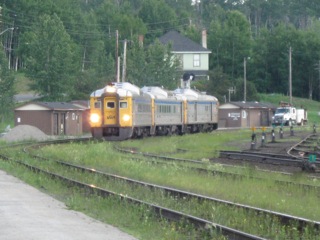
VIA Rail Canada RDCs arrive in White River on June 26, 2010 after an
all-day trek from Sudbury
|
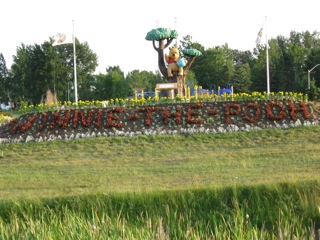
A park along Highway 17 honors Winnie-The-Pooh whose origins
are traced to White River
|
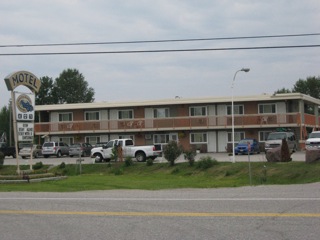 White River Motel offers clean comfortable lodging
and courtesy transportation to the VIA Rail Canada station
White River Motel offers clean comfortable lodging
and courtesy transportation to the VIA Rail Canada station
|
Historic RDCs: Completing My VIA Rail Route Map
Sunday June 27 marked the day in which I would
cover the only VIA Rail Canada line I had yet to travel across.
When one thinks of VIA trains, images of dome cars named for national parks;
dining cars with etched glass partitions; and sleeping cars offering a
variety of accommodations come to mind. VIA train # 186 was, however,
quite the opposite as its three rail diesel cars offered only coach seating
with no food or beverage service whatsoever. We were well supplied
with an ice chest full of sodas and bottled water and sandwiches prepared
at the food shop beside the White River Motel. The motel manager had
offered to transport us to the depot, however, Christine wanted to see us
off since that would likely be the day's highlight. Given the busy
itinerary of our travels, she was all too happy to spend an extra night relaxing
in White River before driving north to Hearst where we would meet up the
next day.
Since the Saturday westbound run had been heavily
booked, an extra RDC had been added to the consist as normally two cars
make up this train. The lead car contained the operating cab and a
baggage section which would be well used for home supplies, canoes, and
various other items carried by passengers. This was followed by an
RDC coach and a third RDC containing seats, an unused snack counter, and
a small baggage room. John and I selected seats in this car (# 6215)
across the aisle from one another which each had a vacant facing seat that
was perfect for stretching our legs. White River residents still refer
to this as the Budd Car Train, in deference to the Budd Company, manufacturer
of these venerable cars. These RDCs are the last ones in regularly scheduled
service in Canada along with those used on Vancouver Island service in British
Columbia. They show their advanced age yet the wingback seats, identical
to those used on VIA long distance coaches were comfortable. Shortly
before our trip, plans were announced to refurbish the RDCs and our conductor
advised that VIA had located retired RDCs in its yards that will be renovated
for this route. This will prevent service disruptions which would
occur were these cars to be pulled from service for updating.
Promptly at 9:00am train # 186 gently glided away
from the White River station along the historic route of Canadian Pacific's
flagship train, the Canadian. For almost two decades VIA Rail has
run the Canadian over the tracks of rival Canadian National, leaving the
White River to Sudbury train as one of few remaining VIA services on CP
tracks. After 20 minutes the rail line passed beneath Highway 17 at
O'Brien and a westbound CP stack train was waiting on a siding. This
would be our last glimpse of Highway 17 until Sudbury as the railway takes
a more direct routing passing through a remote region comprised mostly of
forests, lakes, and streams. Our first stop, Amyot, appears on the
Ontario map but not in the VIA timetable as this train, like most remote
services in Canada, makes flag stops almost anywhere a passenger wants
to go. This stop was made on an embankment in deep woods, yet five
or six men could be seen trackside unloading building supplies from the
baggage car. A small camp house was visible down a dirt path through
the woods that was marked with a "moose crossing" sign.
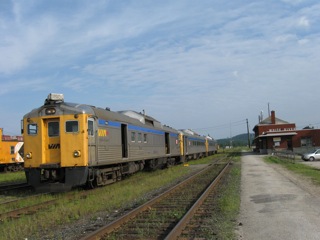 Train # 186 prepares to depart White River, Ontario
on June 27, 2010
Train # 186 prepares to depart White River, Ontario
on June 27, 2010
|
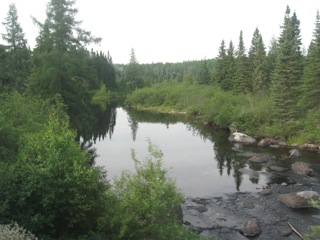 This stream near O'Brien is typical of scenery visible
from VIA # 186
This stream near O'Brien is typical of scenery visible
from VIA # 186
|
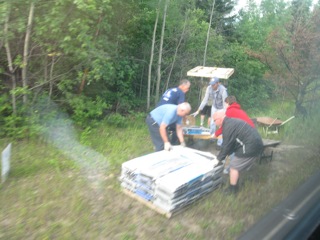
Building supplies are unloaded from the baggage car at Amyot, a remote
stop east of White River
|

Evidence that beavers have been working hard in this river
|
At 10:15am we paused at Milepost 88 to detrain
a family of four. On Saturday a large group from Michigan boarded
here after a fishing expedition at one of three fishing camps in this
isolated area. With no roads within at least 30 miles, the train is
the sole means of reaching these camps. For the next 15 minutes
the rails descended until reaching Franz where we met another westbound
CP stack train. Franz is the junction with the Algoma Central Railway
and in just over 24 hours John and I would again cross this diamond heading
northward. We noted nowhere to wait should a person elect to transfer
from one train to the other as only a few homes were visible anywhere near
the railway.
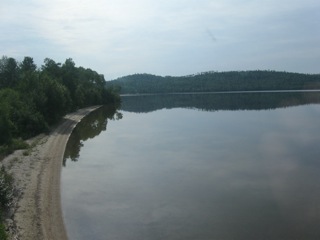
A small beach along one of many lakes passed on our trip to Sudbury
|
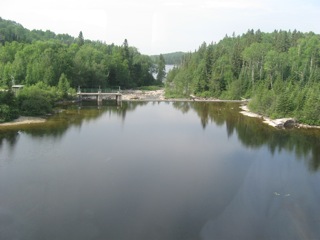
Another lake seen from the right side of train # 186
|
Departing Franz train # 186 made a steep climb en
route to Lochalsh, a stop that is popular with trappers due to its proximity
to the Chapleau Crown Game Preserve whose southern border paralleled the
CP for almost two hours. As if to welcome us to the preserve, two large
sand hill cranes swooped low over the train and settled to a landing beside
a lake. After meeting two more westbound CP freight trains, we arrived
at the crew change point, Chapleau, at 12:45pm. A half hour stop
allowed time to walk the platform, inspect one of the few station buildings
left on this route, and check out Canadian Pacific 2-8-2 steam engine #
5433 displayed behind the depot. Once the new crew was aboard, the
RDCs pulled forward to a fuel rack to take on fuel before continuing the
eastbound trek.
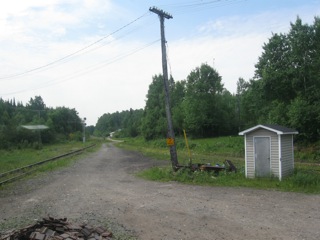
Crossing Algoma Central Railway at Franz. Note there are no facilities
for passengers to transfer from one train to the other.
|
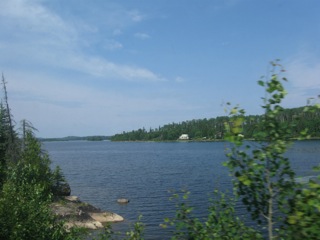 A large lake east of Franz
A large lake east of Franz
|
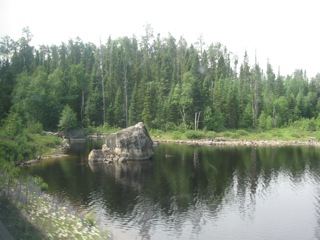
Rocks in many Ontario lakes are evidence of ancient glaciers
|
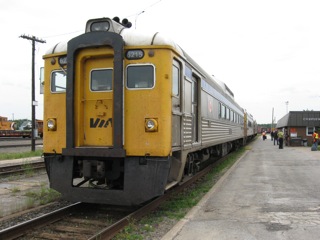 The rear of our train at Chapleau
The rear of our train at Chapleau
|
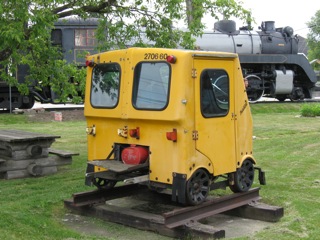
A motorcar displayed outside the Chapleau station
|

Canadian Pacific steam engine on display at Chapleau
|
The afternoon journey featured more lakes, forests,
and streams, meets with more CP freight trains, and stops with interesting
names such as Sultan, Woman River, Metagama, and The Flume. By late
afternoon rock outcroppings signaled that we were truly in the Canadian
Shield where the land is dominated by rocks rather than trees. Soon
we made a 150 foot descent into Sudbury where train # 186 deposited 19 passengers
at a neat brick station that once hosted transcontinental passenger trains.
The present day Canadian stops at Sudbury Jct., located several miles north
of the city. As John and I climbed down from the rail diesel car,
a sense of accomplishment came over me as I had traveled over the entire
VIA Rail Canada system. Coincidentally my first VIA ride had been
in a rail diesel car on the Montreal to St. Foy (Quebec City) route that
long ago left the VIA system map. A post trip check of one of my log
books revealed that Christine and I made that December 30, 1981 trip in VIA
RDC # 6215, the very same car John and I rode from White River to Sudbury.
The trip on this remote service is highly recommended
as it offers good scenery, a ride on comfortable antique rail diesel cars,
and provides insight into a rail service unlike anything seen in the United
States since the 1960s when local trains made dozens of flag stops.
The least complicated way to ride this route is to travel to Sudbury Jct.
aboard VIA Rail Canada's Canadian, spend a night in that city, and ride
round trip to White River. From the northern U.S. it is fairly easy
to drive to White River and make the round trip to Sudbury. The White
River Motel provides good lodging in its namesake community and offers transportation
to and from the railway station as well as a nearby float plane base where
fishermen can fly to remote fishing hotspots. Many people choose
to travel by train one way and fly the other and the motel can assist with
this itinerary. For train reservations call VIA Rail at (888)842-7245
or visit www.viarail.ca. Information about the White River Motel can
be found at www.whiterivermotel.com. During the fall, a company named
Rail Travel Tours offers five day circle trips from Toronto that visit
Sudbury and White River and include a round trip on the VIA RDC as well
as roundtrip between Toronto and North Bay on Ontario Northland Railway's
Northlander.
Our friend Rob Skelly met us at the Sudbury station
and gave us a brief tour of the city. Sudbury is a nickel mining
center and its rich mineral deposits attract geologists from around the
world. Many of these believe that a huge meteorite struck the area two
billion years ago causing the unique geological features. A popular
museum, Dynamic Earth, presents the geological story of this region and
includes a mine tour seven stories below the surface. The Northern
Ontario Railroad Museum in nearby Capreol (served by VIA Rail's Canadian)
preserves early 1900s railroading and includes CN steam engine # 6077, a
wooden caboose, snow plow, electric engines, and a railway superintendent's
home. The Science North Museum, which includes a planetarium and IMAX
theater, and the area's 300-plus small lakes and nearby Lake Huron coastline
are other popular places to visit. Many chain hotels that are popular
in the United States are located in Sudbury which would be convenient during
a layover between the Canadian and the train to White River.
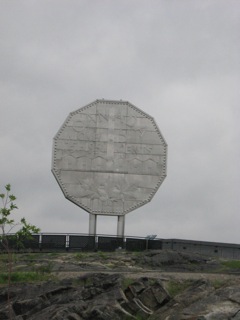
"The Big Nickel" marks the site of Dynamic Earth, a popular science
museum in Sudbury
|
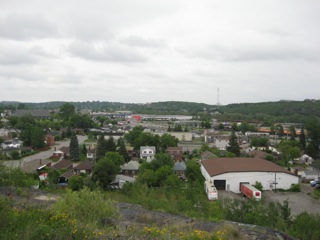
A Sudbury city view from atop the hill where Dynamic Earth is located
|
One of the great obstacles to making our itinerary
work was how we would get from Sudbury to Sault Ste. Marie to catch the
next day's Algoma Central train. Riding a Greyhound bus was one choice,
but the schedule in effect when we traveled would have provided a very close
connection that would be jeopardized if the train from White River were
late. Renting a car appeared the safest option but required a long
taxi ride to the Sudbury airport to pick up the car, a partly nocturnal
drive after a long day on the train, and finding a way to return the vehicle
in Sault Ste. Marie. As good timing had it, shortly before our trip
Rob advised us that he had a meeting in "The Soo" the next day and we were
welcome to ride with him. Good conversation, pleasant scenery before
darkness fell, and the passage of a Huron Central freight train made the
trip seem far shorter than three hours. Midway between Sudbury and
Sault Ste. Marie we stopped for an excellent dinner at the Lake View Inn's
restaurant in Blind River, located on the shore of Lake Huron. Back
in the mid-1960s we could have traveled along this route aboard a Canadian
Pacific rail diesel car.
The night was spent at Algoma's Water Tower Inn,
a charming business oriented hotel in Sault Ste. Marie. This hotel
offers tastefully decorated rooms, a swimming pool, fitness center, and
a comfortable layout that seems perfectly tailored to tourists and business
travelers alike. The hotel's location on the north side of the central
business district is a short drive to the railway station yet convenient
for those driving to or from White River or Sudbury.
|
Algoma's Water Tower Inn offers Sault Ste. Marie's
best lodging
|
The best known attraction in Sault Ste. Marie is
Algoma Central's Agawa Canyon Tour Train which takes riders on a beautiful
day long trip to Agawa Canyon and back. Though summer is popular,
the autumn leaves are the peak season for this train. Other local
attractions include tours of the Sault Locks that allow oceangoing ships
to travel between Lake Huron and Lake Superior, beaches on Lake Superior,
numerous waterfalls, St. Joseph Island, and several cultural centers.
Sault Ste. Marie is approximately six hours from Detroit and seven hours
from Chicago by car and one can reach its sister city of the same name on
the U.S. side of the border by Amtrak Thruway bus. From "The Soo" it
is about a three hour drive to either White River or Sudbury.
Algoma Central To Agawa Canyon and Hearst
The shuttle van from our hotel deposited us at
the Algoma Central station located in front of a shopping mall near downtown
Sault Ste. Marie early on the morning of Monday June 28. The hotel
provides regular courtesy transportation to the airport but, with advance
arrangements, we were able to arrange to be taken to the depot.
The six car Agawa Canyon Tour Train waited on a stub-end track in front
of the depot with F40 locomotives on either end for easy operation to the
canyon and return. Both of the former Amtrak engines and four of the
coaches wore the orange paint job of the Rio Grande Ski Train on which they
previously operated while the dining car and one coach were decked out
in their original stainless silver siding. The original Amtrak road
numbers still were barely visible on the back end of each engine; lead
unit # 105 had been Amtrak # 283 while the rear engine, ACR # 106, began
life as Amtrak # 289.
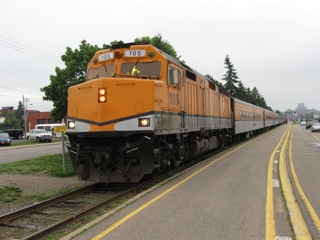
Algoma Central's Agawa Canyon Tour Train prepares to depart Sault Ste.
Marie on June 28, 2010
|
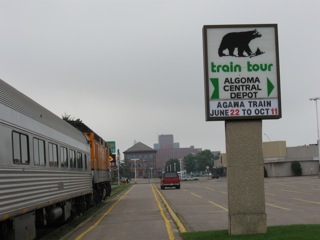
The rear of the tour train stands in front of downtown Sault Ste. Marie
|
Just before the scheduled 8:00am departure time,
the tour train eased out of the station and passed beneath the bridge
we drove across from the United States two days earlier. The Algoma
Central coach yards appeared a couple minutes later then we made our way
to the dining car for a hearty breakfast. The dining car offers a
full menu of sit down meals until late afternoon as well as takeout box
lunches that can be enjoyed at picnic grounds in the canyon. This
particular diner, the Silver Pheasant, has a rich history, having served
in the Burlington Line's equipment pool but not being picked up by Amtrak.
The Algoma Central Railway (ACR) was purchased
by the Wisconsin Central in the 1990s which, in turn, was taken over by
Canadian National in October 2001. Today passenger service on this
Sault Ste. Marie to Hearst line operates under the historic Algoma Central
brand name while freight service is operated by the CN. From early
June to mid-October the Agawa Canyon Tour Train allows one day round trips
between Sault Ste. Marie and Agawa Canyon where passengers are encouraged
to detrain and explore the environs. No intermediate passenger stops
are made and there are no overnight facilities in the canyon except for
an ACR camp car that must be reserved in advance. A tri-weekly all-stops
passenger train operates between Sault Ste. Marie and Hearst; this train
leaves the Sault Ste. Marie yards about an hour behind the tour train.
During winter months the tour train is called The Snow Train which also
runs to the canyon minus the opportunity to detrain there.
A half hour into our journey, the tour train crossed
the Bellevue Valley on a 100 foot tall trestle and the view from the open
vestibule Dutch door was stunning as thick fog obscured everything except
the coach ahead of us. Passengers are not normally granted vestibule
privileges but John and I were given an exception to document the line
for our readers. Beyond the trestle the railway was perched upon
a heavily forested shelf above the Goulais River Valley below on our left.
As we crossed the Goulais River, Mount Searchmont appeared through the
diminishing fog on our right. The line soon took us through what
is known as "Crown Land", a wilderness area owned by the government and
preserved for public recreational use. Canada's roots linked to the
British monarchy are still evident in the use of terms such as Crown Land,
Crown Corporation, and the like to describe government involvement.
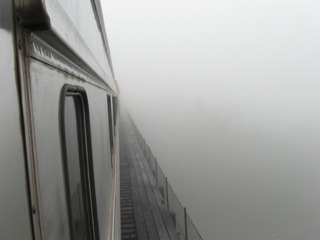
Crossing the 100 foot tall trestle over Bellevue Valley, the train appears
headed into a foggy abyss
|
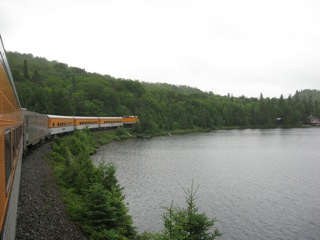
Algoma Central's recently acquired ex-Rio Grande Ski Train coaches still
wear their orange paint scheme
|
The rail route continued to wind through forests and
along lakes as it passed between the many mountains that give the area its
beauty. Three hours into our journey, the tour train crossed the
tall curved trestle over the Montreal River that is featured in many publicity
photos for the Agawa Canyon Tour Train. While most eyes were glued
to the right for breathtaking views of the 130 foot tall trestle that stretches
1550 feet long, observant passengers noted the power dam on the left which
supplies electricity to Sault Ste. Marie and vicinity. During the
next 12 miles the tracks would descend over 500 feet to the floor of Agawa
Canyon. During this stretch magnificent Lake Superior could also be
seen below on the left and we realized that our drive to White River had
brought us within five miles of the railway which was hidden among the
hills. 225 foot tall Bridal Veil Falls soon came into view and a
couple minutes later the train arrived at its canyon stop at 11:55am.

The curved bridge over the Montreal River is featured in Algoma Central
publicity shots
|
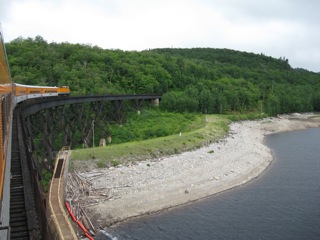
Continuing across the Montreal River
|
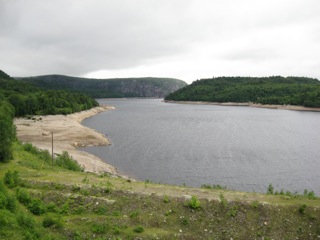
A view upriver as the tour train crosses the Montreal River
|
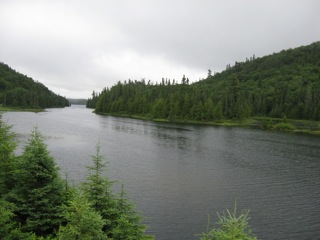
Approaching Agawa Canyon
|
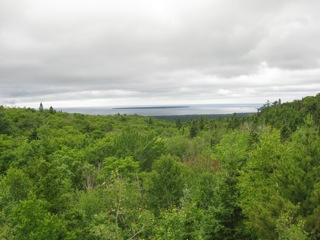
Lake Superior seen from the train at 1600 foot elevation
|

The Agawa River as the train arrives in Agawa Canyon
|
There are numerous trails of varying degrees of
difficulty to hike in the canyon. Three of these reward hikers with
close up views of waterfalls while a fourth trail provides a strenuous climb
of over 300 stairs to an observation deck that allows a bird's eye view
of the canyon. Picnic tables and picnic shelters are set among neatly
manicured grounds near the tracks beside along the Agawa River. After
hiking to the falls, John and I enjoyed the box lunches we had purchased
from the dining car then joined two other passengers in waiting for the
ACR passenger train.

A strenuous climb offered our photographer this view of the canyon.
Note the Agawa Canyon Tour Train beside the shelters in the right center
of the picture.
|
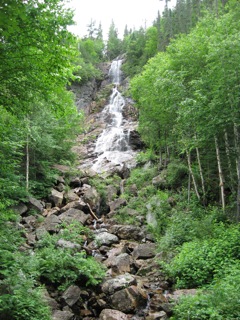
South Black Bear Falls is accessible by a path near the railway
|
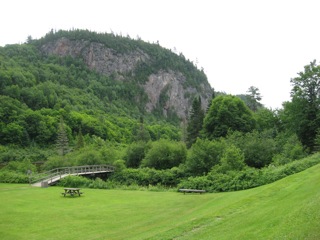
Picnic areas invite passengers to enjoy the stop in Agawa Canyon
|
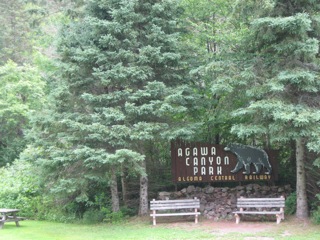
The railway maintains a welcoming setting in the canyon
|
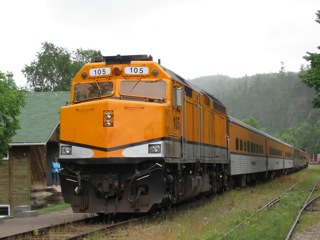
A former Amtrak F40 leads the tour train at Agawa Canyon
|

The heritage of this Algoma Central coach is evident
|
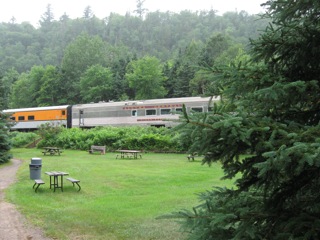
Dining car "Silver Pheasant" originally was operated by the Burlington
Lines
|
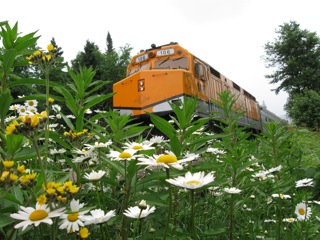
F40 # 106 will lead the tour train on its southbound return to Sault
Ste. Marie
|
Algoma Central sells an interesting combo package
called "Tour of the Line" which allows passengers to ride the tour train
to Agawa Canyon, explore the area for about an hour and a half, then board
the regular passenger train to Hearst. We elected this alternative
to allow us to experience the tour train's amenities including the dining
car and gain more than a passing glance at the magnificent Agawa Canyon.
A regular feature of this package allows passengers to check their luggage
at the Sault Ste. Marie station for transport to Hearst in the regular passenger
train's baggage car. This was very handy as it allowed us to be unencumbered
by suitcases at the canyon.
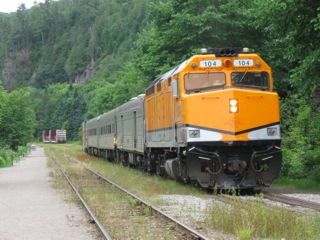
Algoma Central's local train arrives Agawa Canyon en route to Hearst
|
As the tour train eased around a curve at the south
end of the canyon park, northbound ACR # 631, the scheduled passenger train,
came into view on the passing track. After loading its four new passengers,
# 631 resumed its northward trek at 1:35pm with F40 # 104 leading a baggage
car, two coaches, and a generator car. The coaches on this train
were clean and comfortable with nicely upholstered leg rest seats and large
picture windows. The design on the interior panels between the windows
were reminders of these cars' Santa Fe heritage.
Scenic views of the wild Agawa River were evident
for several miles with rock outcroppings, large hills, and lush forests
escorting us northward. At about 3:15pm the busy stop in Hawk Jct.
boarded eight passengers, many of whom loaded supplies and fishing gear
into the baggage car. The 10 minute stop provided enough time for
a quick look inside the station which houses historical photographs of
the railway and adequate time to take a few pictures of our train for our
records. Of particular interest to us was the generator car on the
tail end of train # 631 as it appeared to be a former Amtrak material handling
car. This car was recently refurbished at CN shops in Homewood, IL
and has been painted in the attractive Algoma Central livery with the words
"Tracks of the Black Bear" on its sides.
Hawk Jct. used to be the point where a short branch
line to the town of Wawa diverged. This line has been abandoned as
highway access links these towns. After departing from the station
# 631 backed into a siding to allow a southbound CN freight train to pass;
this well executed meet delayed us only four minutes. An hour later
we crossed the Canadian Pacific transcontinental line at Franz. John
and I had traversed this same spot eastbound the prior day aboard the
VIA rail diesel car train and once more we noted that it was not a place
where one should attempt to change trains. Our conductor, Gary,
a 40 year veteran on the ACR, told us the story of a young couple who,
years ago when the Canadian ran on its traditional route, insisted on
making the transfer at Franz despite warnings that there was no station,
no food, and no shelter. Thankfully, a local family took them in until
the Canadian arrived as the wait would have been several hours.
Indeed on our trip, there was no business and # 631 did not stop at
Franz.
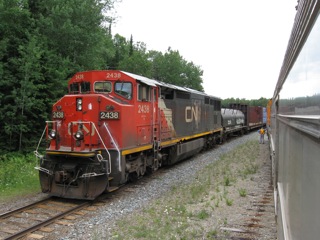
A southbound CN freight passes just north of the Hawk Jct. depot
|
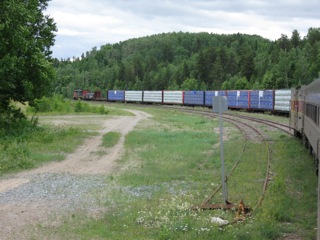
The passenger train backed into this siding to allow the CN freight to
pass
|
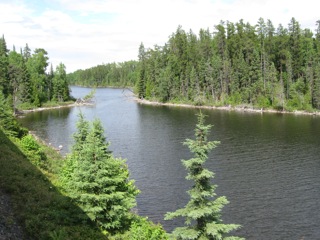
Remote river scenes escort train # 631 northward
|
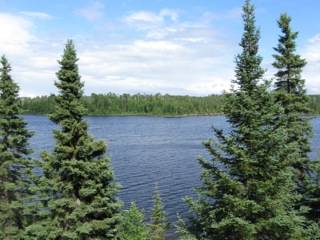
Rich forests and sparkling waters south of Franz
|
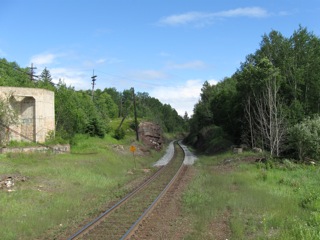
Crossing the Canadian Pacific main at Franz. We crossed this spot
the prior day aboard VIA Rail Canada # 186. It is not advisable to
attempt a connection here.
|

This distinctive indian logo dates to the Santa Fe heritage of many Algoma
Central coaches.
|
Eight people did detrain 20 minutes later at Errington
Wilderness Camp and a portable ramp was attached to the baggage car doors
to facilitate the unloading of luggage, ice chests, and supplies.
Several small boats waited to transport these guests to a lodge across the
adjacent lake. Another interesting stop followed 10 minutes later
at Oba Lake, where a passenger stepped off the train right at her front door
and unloaded a large amount of provisions from the baggage car. Soon
we crossed a series of bridges over lakes where small fishing boats were
engaging anglers in late afternoon fishing outings.
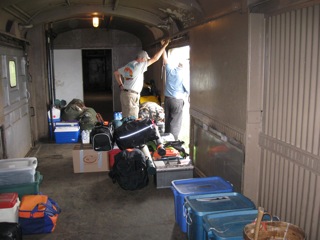
Baggage and supplies keep the baggage car busy on train # 631
|

Boats are lined up to take passengers to Errington's Wilderness Island
Resort
|
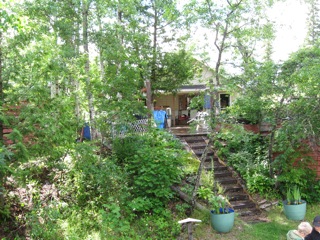
At one stop, a passenger detrained right in front of her house at Oba
Lake
|
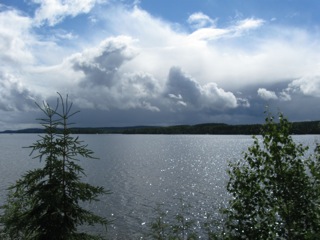
Another scenic lake
|

One of many fishing boats on lakes south of Oba
|
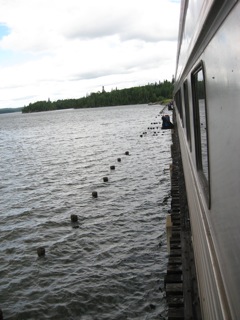
Crossing a bridge between Oba Lake and Price
|
At 6:15pm the ACR line gently curved to the left
and joined the Canadian National transcontinental main line at Oba.
The stop at Oba actually was at a street crossing where a pickup truck
backed up to the baggage car and unloaded the fishing gear, ice chest,
and luggage of a family from Kentucky who was on a northern Ontario fishing
expedition. No station was evident and, as we noted on last year's
trip aboard the Canadian, this would not be a good place to switch from
one train to the other.
After discharging the family our train slowly snaked
its way through the Oba yard, emerging at the west end where the ACR line
again diverges from the CN. A CN freight that had left Sault Ste.
Marie in the early morning was finally caught at the far end of the Oba
yard, resulting in a brief delay as it backed down into the yard to clear
the way for # 631. The final hour of our all day trip took us through
farmlands and crossed rivers until towering stacks of logs, harvested from
the region's forests, signaled our entry into Hearst. Arrival in this
northern Ontario community of 5,600 residents came at 7:45pm, almost 12 hours
after we left Sault Ste. Marie. We were grateful to find Christine
waiting at trackside as the train came to a halt as she had driven remote
highways earlier in the day from White River to Hearst by way of Hornepayne.
Our lodging this night was at the Companion Motel, a comfortable property
whose parking lot backs up to the train's boarding/detraining point (there
is no station in Hearst).
A ride on the Algoma Central is highly recommended
whether it is simply a round trip on the Agawa Canyon Tour Train or a
trip over the entire line. We found that the trip passed very quickly
and surprisingly without tedious stretches. It is possible to ride
on this line without making a round trip as Ontario Northland busses link
Hearst with Cochrane where one can catch a train to Toronto. The
combo trip that allows one to ride the tour train to the canyon then the
passenger train to Hearst is only available northbound and it is imperative
to check schedules closely since the tour train runs seasonally and the
passenger train operates tri-weekly. Southbound passengers can, of
course, ride all the way aboard the scheduled passenger train. It
is not advisable to attempt connections with VIA Rail at either Franz or
Oba due to the total lack of shelter, station facilities, or food.
It is also well to come prepared when riding the regular passenger train
since no food or beverage service is offered.
The Polar Bear Express To Moosonee
After a rare chance to sleep in the next morning,
we packed up and drove eastward to Cochrane. The weather was a combination
of nasty cold and rain with temperatures in the 40s and a steady rain
making it feel even cooler. Some of our fellow passengers from the
Algoma Central trip had boarded an Ontario Northland bus to Cochrane in
the pre-dawn hours to allow a connection to this day's Polar Bear Express
train. We were glad to be taking it a bit more methodically.
Midway in our three hour drive, we paused in Kapuskasing
to look at a preserved steam engine and old coaches that were used to transport
people (mostly of Ukranian descent) to an internment camp near this community
during World War I. After picking up lunch we spotted a westbound
Ontario Northland Railway (ONR) freight train bound from Cochrane to Hearst.
Passenger service once was operated on this route but was replaced by Ontario
Northland busses as the railway today is restricted to 10 mph operation.
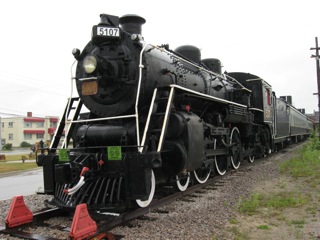
A World War I era train displayed at Kapuskasing
|
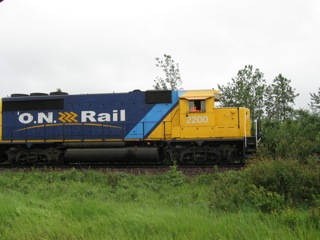
A westbound ONR freight between Hearst and Cochrane
|
We were welcomed to Cochrane by its notable polar
bear statue which I remembered seeing on a 1991 visit. On that trip
I rode an overnight VIA Rail Canada train from Montreal, spent the night,
then rode ONR's Northlander to Toronto. This time we would aim a bit
farther north and ride the Polar Bear Express to Moosonee. While our
motel in Hearst had been convenient to the railway, the Station Inn in Cochrane
was downright perfectly located. When I last visited in 1991, the
two story motel was under construction at the Cochrane station.
Now, 19 years later, we would have the opportunity to experience this convenient
accommodation. The front desk was across the station waiting room from
the ONR ticket office which is perfect for passengers traveling by train
to Toronto or Moosonee as well as by bus from Hearst. Rooms in the
Station Inn are clean and comfortable and either offer a view of a preserved
steam train on the north side of the depot or the platform tracks to the
south. The Station Inn's restaurant proved an excellent choice for
dinner while, for breakfast, we made a quick visit to Tim Horton's, the iconic
Canadian doughnut shop.
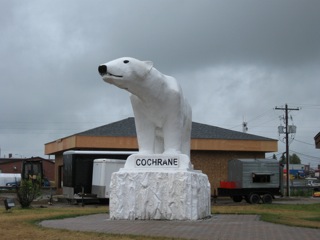
Iconic welcome center statue in Cochrane
|
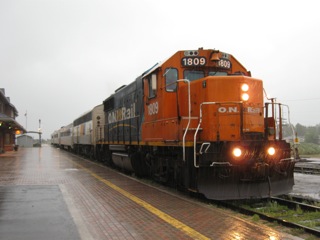
The Northlander arrives in Cochrane on a chilly, rainy evening
|
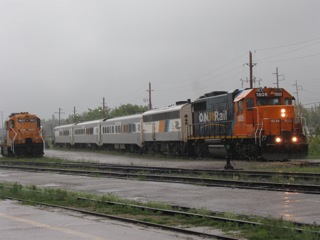
The Northlander backs into the yard at Cochrane
|
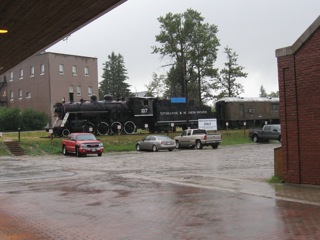
This steam train stands outside the Cochrane station and was visible
from our second floor hotel room
|
The last day of June 2010 was a bit nicer than
the previous day though still on the cool and damp side. The Polar
Bear Express was already boarding when we came down from our room and we
appreciated this convenience. We located our pre-assigned seats in
coach 856 and were surprised to find the train filled with more local travelers
than typical tourists whom we had expected. In the winter ONR operates
an all-stops local mixed train known as the Little Bear. During summer
the Polar Bear Express takes on the role of tour train and local passenger
train with no distinction between the two very different types of clientele.
Equipment on the Polar Bear Express was a similar
mixture of both tour train cars and basic coaches. Five coaches contained
assigned seating, a regular dining car and a flat end observation dining
car provided sit down meal service, and a lounge car sold snacks
and beverages. Additionally, an entertainment/snack bar car housed
a singer and another place to relax and a full dome car named "Otter Rapids"
was popular with tourists but largely ignored by the native population.
The heritage of the observation-diner and the full dome provided the feel
of classic American railroading as the former served the Chesapeake &
Ohio Railway while the dome had been a Milwaukee Road "Super Dome".
One of the coaches originally belonged to the Norfolk & Western while
others were former VIA dayniters converted from original Canadian National
sleepers.
|
Ontario Northland's "Otter Rapids", a former Milwaukee
Road Super Dome, offered a great view of the route from Cochrane to Moosonee
|
Leading the Polar Bear Express were two ONR GP-38
engines followed by three flatcars loaded with passengers' automobiles
and pickup trucks. This service is the only means of transporting
vehicles to Moosonee which has no roads to the outside world. Vehicles
are chained down atop the open flatcars which are spotted at an unloading
ramp shortly after arrival at Moosonee or Cochrane. A box car hauling
postal mail followed the flats northward trailed by the passenger cars.
A baggage car, and FB unit used as a power generator, and two more box cars
used for baggage and express brought up the rear of the train. Indeed
we were riding a true mixed train.
|
Several vehicles are transported on flatcars behind
the engines on the Polar Bear Express
|
Forty minutes into our trip the Polar Bear made
its first stop at Wurtele which was merely a spot in the woods. At
10:15 we crossed a tall trestle over Trappers Creek, elevation 755 feet.
The view from the dome car was outstanding as the train passed through the
northern Ontario woodlands, frequently punctuated by lakes and rivers.
The wide Abitibi River was traversed at 10:30am and Red Sucker Creek 15
minutes later. A southbound ONR freight train rolled by a few miles
after this and we noted a minivan atop a flatcar in its consist. Our
stop in Fraserdale marked the last highway we would cross until the local
streets of Moosonee over two hours later.
At high noon a large hydroelectric plant appeared
on the right at Otter Rapids while power lines on the left traveled northwestward
to remote diamond mines. It was time for lunch in the dining car
and we opted for the observation car where we were seated at a table right
in front of the end windows. This car operated in reverse on the northbound
trip so the observation windows looked forward toward the back of the mail
car. On the return trip we would have an unobstructed rear view as
this would be the last car. While John and I enjoyed roast beef sandwiches
for lunch, Christine enjoyed a meal from the breakfast menu, commenting
that this dining flexibility was a pleasant change.
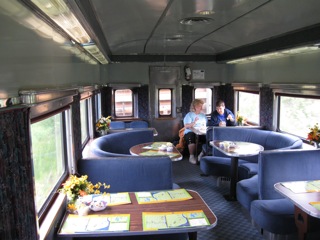
A former Chesapeake & Ohio diner-observation
car serves lunch and dinner on the Polar Bear Express
|
During lunch the scenic highlight of the trip came
as we crossed a tall trestle over the wide Moose River at about 1:25pm.
Large stones and sand bars dotted the river making this an interesting crossing.
By 2:45pm the Polar Bear Express pulled into Moosonee where the sold out train
discharged over 200 passengers, many of whom proceeded to the baggage car
to unload their belongings. Beyond the notice of most passengers, the
duo of engines were busy switching the flatcars onto a siding where an unloading
ramp would permit transported vehicles to be delivered to their owners.
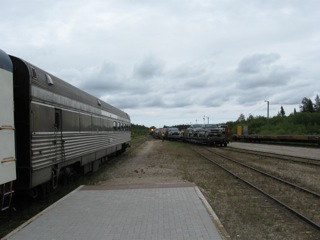
Flatcars are switched at Moosonee to allow unloading of vehicles
|

Dome car "Otter Rapids" at Moosonee
|
Brightly colored cars include the Polar
Bear Express logo in the lower right corner
|
Several travelers on a day excursion opted for
informal tours to nearby Moose Factory, located across the Moose
River from Moosonee. That outpost has historic roots in serving traders
coming from Hudson Bay into James Bay. Rather than that activity,
we decided to watch the switching operations at the station before taking
a walk around the town and eventually relaxing on a bench overlooking the
river. Time passed quickly and we returned to the station in time to
watch southbound passengers load their wares into the baggage car then
found seats in the dome car. Inside one of the box cars we noticed
two used washing machines that someone was transporting either for repair
or trade-in. Another passenger's German shepherd was loaded into
the baggage car along with a variety of coolers, boxes of groceries, and
beverages. The Moosonee station is staffed and has a climate controlled
waiting room, the only such facility north of Cochrane.
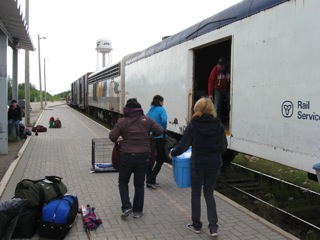
Passengers load a variety of items in the baggage car before the southbound
departure from Moosonee
|
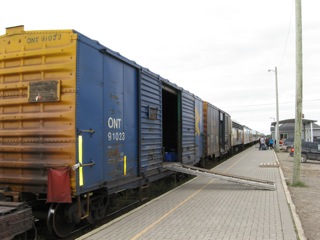
Box cars handle postal mail and checked express items from Moosonee to
Cochrane
|
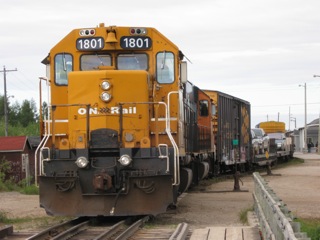
The southbound Polar Bear Express awaits departure from Moosonee via
a bridge across Store Creek
|
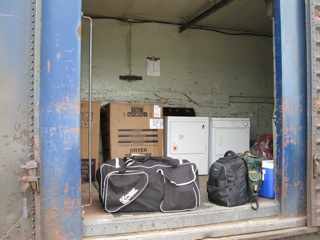
Washing machines and clothes dryers are among the baggage and express
transported in one of the box cars aboard the Polar Bear Express
|
The Polar Bear Express departed Moosonee at 6:00pm
with another full passenger load, four flatcars loaded with vehicles,
and otherwise the same consist as on the northbound journey except with
all baggage and mail cars up front. As train pulled out, Store Creek
(elevation 18 feet) was crossed on a timber trestle. Forty-five minutes
later we made our way to the rear of the train for dinner in the diner-observation
car. The view of the tracks receding behind the train was reminiscent
of childhood trips aboard observation cars on the Silver Meteor and City
of Miami though those trains did not offer dining in their rear cars.
The menu was varied but we all selected the chicken florentine with mashed
potatoes, mixed vegetables, and a roll. Dessert and beverage were included
with the meal and we each ordered a slice of tasty blueberry pie along with
hot tea. There was no hurry to vacate our table which allowed us to
enjoy the Moose River crossing at about 7:20pm. The late afternoon
light combined with the rear facing windows provided a different perspective
of the scenic river.
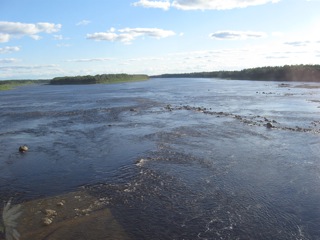
Crossing the Moose River as seen from the observation car
|
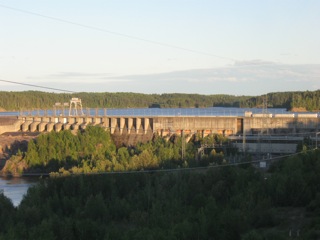
Otter Rapids Hydro Generating Plant
|
Back in the dome there was an interesting view
as the day slowly faded to night. Puffy clouds and blue skies turned
to streaks of orange that silhouetted the trees along the railway.
Eventually the last vestiges of dusk gave way to total blackness at about
10:30pm and stars and planets dotted the heavens above. Our arrival
back in Cochrane was an hour late at 11:45pm and within a couple of minutes
we were back in our room at the Station Inn.
Heading To Toronto
Canada Day marked the start of our trip home as
we loaded up the van and Christine and I headed south on Highway 11.
We had put John on Ontario Northland's Northlander at 8:00am for the trip
south to Toronto. Having made that trip in 1991 made it easier to watch
the train pull out without me aboard. After spotting the train about
a 45 minute head start, we finally caught up at North Bay where we were able
to surprise John by standing on the platform as the three car train pulled
in.
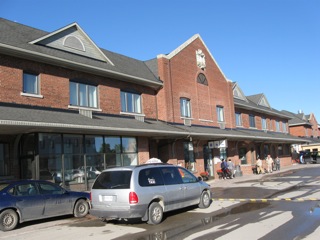
Cochrane depot with the Station Inn on the second floor
|
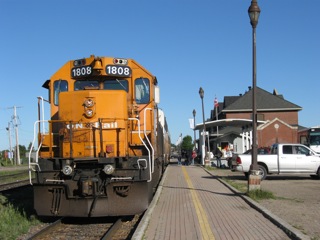
The southbound Northlander departs Cochrane on July 1, 2010. The
depot and the Station Inn are at right.
|
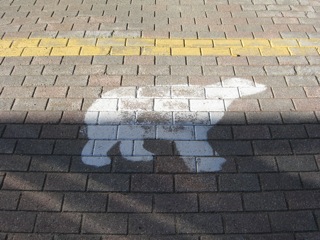
Polar Bear logos are painted on the Cochrane station platform
|
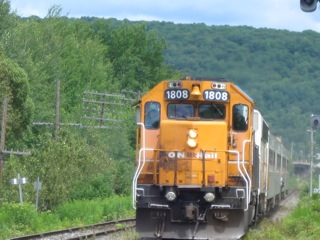
The southbound Northlander arrives in North Bay. The author and
his wife surprised John who was riding the train to Toronto.
Photo by Jack M. Turner
|
Our all day drive finally got us to Toronto by
late afternoon where we settled into our sizable suite at the stately
Fairmont Royal York Hotel. A phone call from the lobby surprised
us as John had arrived almost an hour early after his all day train trip.
For a report on John's trip aboard the Northlander, see his article Gem
of the North: Riding ONR's Northlander which can be accessed via the link
at the bottom of this story. We found dinner at Piper's Pub to be amazing
and we were delighted we had bypassed the urge to explore other area eateries.
Piper's is located on the lower level of the Royal York along a corridor that
connects the hotel to Toronto Union Station.
The suite was perfect for relaxing as it had ample
sofa and easy chair seating with beautiful furnishings. Outside
our window, 18 stories down, the westbound Canadian began its transcontinental
journey to Vancouver after 10:00pm. We could only imagine the anticipation
experienced by its passengers as the majestic streamliner set out on a
voyage across the vast Canadian countryside. No doubt, many were getting
ready to turn in for the night in their roomettes and bedrooms while others
were likely watching the city skyline from the dome cars.
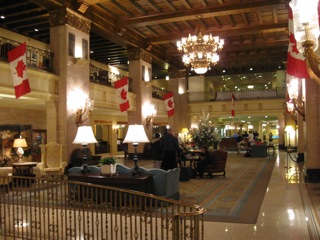
The lobby of the stately Fairmont Royal York where many movies and television
shows have been filmed. Recently, the TV series "Covert Affairs"
filmed a scene here.
|
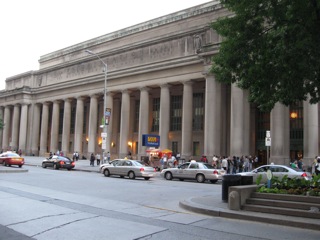
Toronto Union Station as seen from the entrance to the Royal York
|
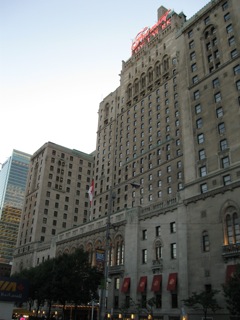
The Royal York as seen from the front of Toronto Union Station
|
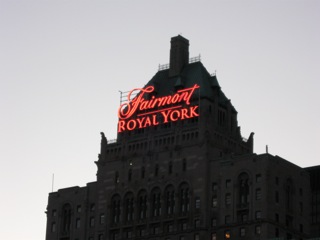 The neon sign identifies the Royal York as seen from
the Union Station commuter platform
The neon sign identifies the Royal York as seen from
the Union Station commuter platform
|
The Royal York was the tallest building, 29 floors,
in the British Empire when it opened in 1929. The hotel was constructed
by the Canadian Pacific Railway to serve its rail passengers with a convenient
luxury hotel across Front Street from Union Station. As such,
the Royal York was the flagship hotel for the Canadian Pacific as it ushered
in a series of magnificent hotels along its transcontinental railway.
The hotel's lobby is a work of art as it contains a hand painted ceiling,
ornate crystal chandeliers, wall hangings, and majestic pillars.
Whether housed in a standard room or a luxurious suite, guests will find
a stay at the Royal York a highlight of their travels. Marble floors and
counters graced the bathrooms in our suite and even the elevators displayed
an elegant look.
The guest list over the Royal York's 81 years reads
like a political and entertainment Who's Who including such dignitaries
as Queen Elizabeth II, Mikhail Gorbachev, Margaret Thatcher, and Henry Kissinger
and celebrities such as Frank Sinatra, Bob Hope, Jerry Lewis, Perry Como,
William Shatner, Richard Gere, Ann Margaret, Wayne Gretzky, Gene Kelly,
Christopher Plummer, Cary Grant, Lloyd Bridges, Mikhail Baryshnikov,
and Dolly Parton. Famous directors including George Lucas and Francis
Ford Coppola have made this hotel their home while visiting Toronto.
The list goes on and on with over 40 million guests, the famous and not so
famous, registering at the Royal York. Scenes from a number of movies
have been filmed in various parts of the hotel through the years and the
current television series "Covert Affairs" has included many scenes shot
in the hotel. In short, the Royal York is THE place to stay in Toronto.
Back in the USA: Riding My Last Amtrak Route
An easy morning drive from Toronto to Dearborn,
MI positioned me to ride the last segment of Amtrak's national system that
had to date eluded me. The Dearborn station parking lot was packed
which indicated business is good on the route between Chicago and Detroit.
In reality only the Detroit to Pontiac segment would be new for us, however,
Dearborn was a more convenient boarding location. Once more John
and I would make this ride while Christine kindly drove to Pontiac to pick
us up.
Train # 350, the Wolverine, discharged a large
crowd at Dearborn after which we boarded and found the last two seats
in the lead Horizon fleet coach. Soon we decided to move to the Amfleet
cafe car one car forward for a better view of the route. The train
had a P42 engine on each end since there are no turning facilities adjacent
to the Pontiac station. The Amcafe and four Horizon coaches provided
approximately 300 seats and were mostly filled to capacity.
The eastbound Wolverine pulls into Dearborn
|
Our 2:07pm departure from Dearborn was over 30
minutes late though a few minutes were shaved off that deficit at each
station. We met a CP freight near West Detroit then an opposing CN
freight near Vinewood after bearing off from the line that headed toward
central Detroit. Just beyond the Detroit Amtrak station, the Wolverine
branched off to a northwesterly route at CN's Milwaukee Jct. For
most of the short trip, the railroad passed industrial sections, rail
yards, houses, and businesses. The latter were most prevalent near
our next busy stop, the upscale suburb of Royal Oak. Seven minutes
after that stop, the Wolverine paused again and detrained a good crowd
at Birmingham. Beyond that community we zipped past a golf course
and a rural area that was quite different from the rest of the route.
Arrival in Pontiac came at 3:12pm, only 5 minutes late; indeed the schedule
had been well padded.
No marching bands were there to greet us.
No mayor waited to offer the key to the city. Even my wife was nowhere
to be found as traffic and a confused GPS unit had held her up.
It didn't matter as I was ecstatic to have finally ridden every mile currently
traversed by Amtrak trains. We were glad to not have to wait for
the return train 2 1/2 hours later as there was no Amtrak station, only
a modular Greyhound station across the parking lot from the train platform.
|
The author happily celebrates riding his last missing
piece of the Amtrak system as he stands by the Wolverine at Pontiac
|
Our lodging selection for the night, the Dearborn
Inn, was a charming property opened by Henry Ford in 1931 to provide quality
lodging near the Ford Airport (which closed two years later) and his vehicle
design and assembly plants. The Georgian style inn features an Early
American decor in its lobby, public rooms, and guest rooms and is located
on a 23 acre site. The inn bears a striking resemblance to some of
the colonial inns and lodges in Williamsburg, VA right down to the beautifully
landscaped grounds that surround the property. The back lawn behind
the inn includes a gazebo and several small guest cottages resembling the
homes of notable Americans such as Edgar Allan Poe, Walt Whitman, and Patrick
Henry are available as guest lodging. Contemporary conveniences including
wireless Internet access and a large swimming pool keep the inn in step
with the times. Since 1989 the Dearborn Inn has been operated by Marriott
Hotels.
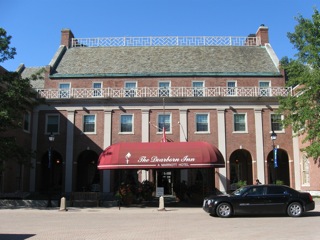
The Dearborn Inn, built by Henry Ford, is a terrific property convenient
to Amtrak and area attractions
|
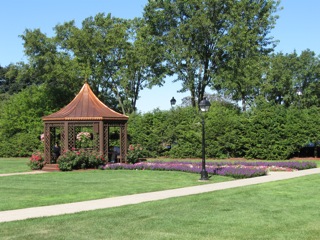
Manicured grounds make the Dearborn Inn an appealing place to relax
|
Homes behind the Dearborn Inn replicate famous Americans' residences
|
Among the notable guests to have stayed at the
Dearborn Inn are Orville Wright, Ronald Reagan, Bette Davis, Jesse Owens,
James Doolittle, Charles Lindbergh, Bob Hope, Norman Rockwell, and Walt
Disney. This inn is located right down the street from Dearborn's
number one attraction, The Henry Ford Museum and the extremely popular
Greenfield Village. The Amtrak station is just a short drive from the
Dearborn Inn, making it an excellent place to combine with a rail trip.
The Henry Ford, as locals call it, houses an incredible
collection of Americana, from a round aluminum house that in the 1950s
was thought to be the home of the future, to steam engines and rail cars
from a number of large and small railroads. The bus in which Rosa
Parks refused to give up her seat is a major piece of the collection as is
the limousine in which President John F. Kennedy was assassinated. From
the aviation world, a classic DC-3 plane hangs from the ceiling while nearby
easily recognizable original Holiday Inn and McDonald's signs flash their
neon. All told there are enough items to view that one could easily
spend a half day inside.
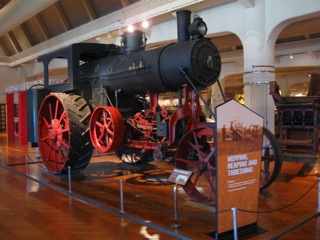
This combination mower/thresher/reaper, displayed at the Henry Ford Museum,
looks like a steam locomotive
|
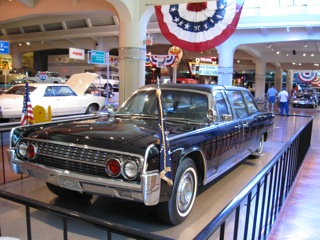
The Henry Ford Museum collection includes the limousine in which President
John F. Kennedy was assassinated
|

A C&O steam locomotive is part of the collection at the Henry Ford
Museum
|
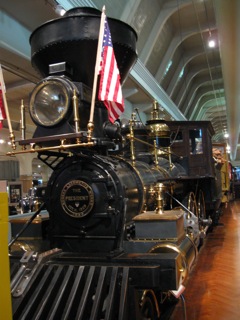
Antique rail equipment, automobiles, and aircraft are part of
the display at the Henry Ford Museum
|
Another major attraction, Greenfield Village, stands
directly behind the Henry Ford Museum and is part of the same complex.
Greenfield Village recreates an early 1900s community complete with antique
cars and busses that drive along the streets of the town. Costumed
interpreters play the role of period politicians, ice cream vendors, and
even Orville and Wilbur Wright. Shops, churches, a railway depot,
farmhouses, and other structures give Greenfield Village an authentic feel.
A steam engine hustles open passenger cars around the village much to the
delight of children who have never stepped aboard a train. At the
rear of the village, the main line that hosts Amtrak's Chicago to Detroit
to Pontiac trains is clearly visible and there is even an Amtrak platform
though trains only stop for groups with prior reservations.
Our other major activity in the area was an evening
major league baseball game at Comerica Park, home of the Detroit Tigers.
This new stadium is an excellent place to see a game with good visibility
from the seats and a pleasing environment. The Seattle Mariners were
in town the night we attended and Tiger fans were in full force to support
their team to victory. Following the game we enjoyed Friday night
fireworks at the stadium and watching the display from our comfortable stadium
seats close to the action was a unique experience. Travel time from
our hotel to the stadium was about 20 minutes, not bad for a major city
on a Friday night.
Dayton: Aviation Central
The drive to Dayton was easy after our morning
visit to the Henry Ford and Greenfield Village and we found the Hilton
Garden Inn in Dayton's Beaver Creek suburb to be an attractive property.
The look of the hotel and the newness of the businesses close by made it
apparent that this was a recently built property. With many restaurants
and stores nearby, this was another convenient place to stay. Our room
was spacious and the indoor pool was a plus after a busy travel week.

Hilton Garden Inn in the Beaver Creek suburb of Dayton
|
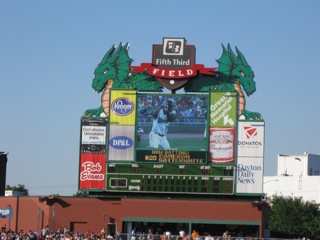
The Dayton Dragons battle the Great Lakes Loons
|
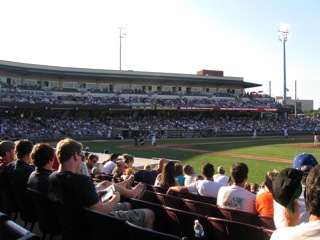
Dayton Dragons games are popular in central Ohio
|
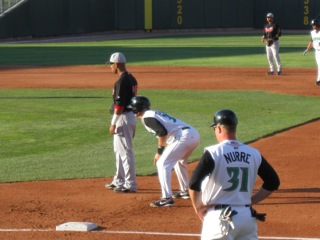
The Dragons battle Great Lakes at Fifth Third Field
|
During the evening we drove downtown to attend
a Class A minor league baseball game between the Dayton Dragons and Great
Lakes Loons. While minor league baseball was very popular everywhere
we went, the sell out crowd at Fifth Third Field in the center of downtown
was the largest of our trip. Like most stadiums, this one had its
own unique character and we enjoyed the many between innings promotions
and contests that kept the crowd engaged. As we departed the downtown
area we saw a passing freight train which evoked thoughts of the oft-proposed
3-C corridor that would link Cleveland, Columbus, and Cincinnati by rail,
most likely via Dayton.
The following morning we visited the National Museum
of the United States Air Force located at Wright Patterson Air Force Base,
a short drive from our hotel. This huge facility houses an incredible
variety of aircraft including bombers from World War II, the Vietnam War,
the Korean War, and more recent conflicts. Memorabilia from USO
shows performed through the years for the troops are displayed, with jackets
and a golf club used by Bob Hope the most recognizable items. By arriving
early it was possible to register for a visit to a hangar housing several
aircraft that were designated Air Force One for presidential use through
the years. The star of this show was the Boeing 707 jet that carried
President John F. Kennedy to Dallas then ferried his body home on a fateful
November 1963 trip. His successor, Lyndon B. Johnson was sworn in aboard
this aircraft. Visitors were allowed to walk inside this historic airplane
and it was chilling to realize the historical significance of this jet.
For me, this brought things full circle as I had stood behind the rope
line beside this plane in Miami just before JFK flew to Dallas.
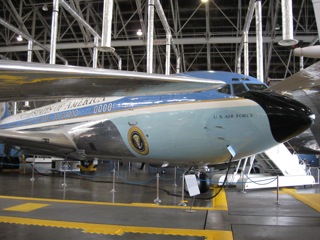 This Air Force One jet served through the Clinton
presidency. It is most noted for transporting JFK's body back to Washington
after his assassination in Dallas in 1963. Lyndon B. Johnson was
sworn in aboard this aircraft at the Dallas airport.
This Air Force One jet served through the Clinton
presidency. It is most noted for transporting JFK's body back to Washington
after his assassination in Dallas in 1963. Lyndon B. Johnson was
sworn in aboard this aircraft at the Dallas airport.
|
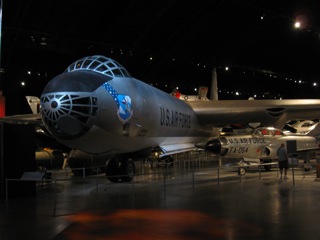 A variety of military aircraft are housed in the USAF
Museum in Dayton
A variety of military aircraft are housed in the USAF
Museum in Dayton
|
Fourth of July in Louisville
Independence Day 2010 was spent making the short
drive to Louisville after our visit to the Air Force museum in Dayton.
Our first activity in Louisville was an afternoon at Churchill Downs, home
of the Kentucky Derby. Like so many other sights along our trip,
the famous twin-spired racetrack, which opened in 1875, is listed on the
National Register of Historic Places. July 4th was the last day of
horse racing at Churchill Downs during the 2010 spring meet. We enjoyed
watching several races including one in which 2009 Kentucky Derby winner
"Mine That Bird" entered his first race at Churchill Downs since that victory.
Watching horse races from box seats in the grandstand was exciting as we
were able to take in the entire race experience then relax in the air conditioned
clubhouse between races with a stop by the paddock to see the horses up
close. Adjacent to the track was the Kentucky Derby Museum which preserves
Derby history in the form of trophies, photos, and memorabilia from that
race's long and storied history.
During the evening we enjoyed a leisurely trip
on the Ohio River aboard the paddlewheel boat "Belle of Louisville".
The magnificent paddlewheeler was built in 1914 as the "Idlewild" and spent
several years in ferry service out of Memphis. During the 1920s and
early '30s she regularly traversed the Ohio, Illinois, Mississippi, and
Missouri Rivers. In the late 1940s she was sold and renamed "Avalon"
and she served ports from Omaha to Nashville to Montgomery, WV. By 1962
she had fallen in disrepair and was auctioned off. Her new owners refurbished
the steamer and the next year she debuted in excursion service as the "Belle
of Louisville" based in her namesake city. Today the Belle is recognized
as the oldest operating steamboat in America and she also is listed as a
National Historic Landmark.
Our two and one-half hour cruise took us up the
Ohio, passing beneath several highway and railroad bridges then anchored
in mid-river for a 10:00pm fireworks show. The display was outstanding
as the fireworks were launched from a barge in the river with the bridges
and city skyline framing the scene. The Belle of Louisville offers
various sightseeing cruises on the Ohio River with many including food and
beverage service. Information can be located at: www.belleoflouisville.org.

Passing beneath bridges at Louisville as the Belle of Louisville cruises
up the Ohio River
|
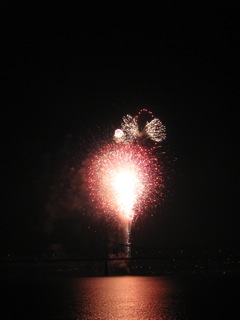
Fireworks on Independence Day 2010 as the Belle of Louisville is anchored
in the Ohio River
|
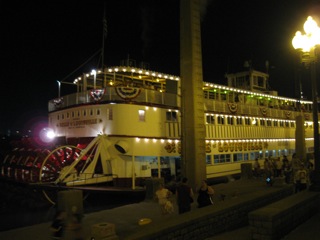
Paddlewheeler "Belle of Louisville"
|
The Courtyard by Marriott in downtown Louisville
was our lodging on this evening and it proved to be a good choice as it
was a short walk from the boat dock, a 10 minute drive from Churchill Downs,
and close to the next morning's destination: the Louisville Slugger Museum.
As with our previous hotels, a good night's sleep was enabled by our quiet
room which was a few floors above the city streets.
The following morning we drove a few blocks to
the Louisville Slugger Museum, home of the Louisville Slugger baseball
bat factory. Outside the museum, a 120 foot tall replica baseball bat
leaves no doubt about what's inside. As soon as we stepped into the
museum, we were invited to hold a baseball bat used by Mickey Mantle during
games. Of course, before taking hold of the bat, we were given cotton
gloves to protect the bat. Several significant pieces of baseball history
were displayed for visitors then a fascinating tour of the Louisville Slugger
factory followed. There we learned about and observed the making of
wooden baseball bats, most of which are used by major league players.
This interesting tour is a must-see during a visit to Louisville and can easily
be fit in with most itineraries.
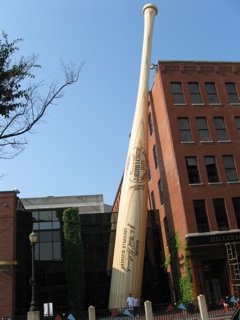
Louisville Slugger Museum
|
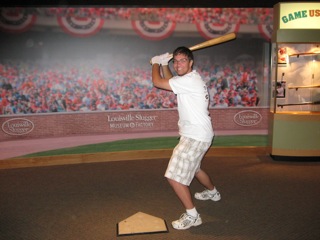
John Turner poses with a bat used by Mickey Mantle
|
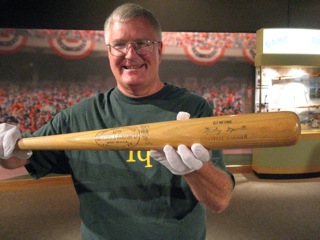
The author is thrilled to hold the bat of his childhood hero
|
On our way out of town we drove past the former
Louisville & Nashville Railroad headquarters a few blocks south of
the Louisville Slugger Museum. Just west of that building we passed
the grand former Louisville Union Station, a stately limestone building
that opened in 1891. This station once hosted trains such as the PRR/L&N/
ACL Chicago to Florida South Wind, L&N's Cincinnati to New Orleans
Humming Bird and Pan American, Monon's Chicago to Louisville Thoroughbred,
and C&O's Louisville section of the George Washington from Washington,
DC and Newport News, VA. Amtrak served the station during the 1970s
with its Chicago to Florida Floridian and outfitted a track on the station's
west side for its Kentucky Cardinal in the early 2000s.
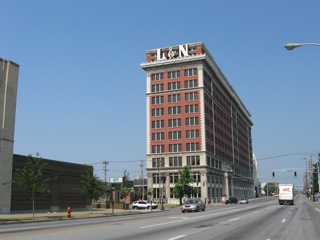 L&N Railroad headquarters
L&N Railroad headquarters
|
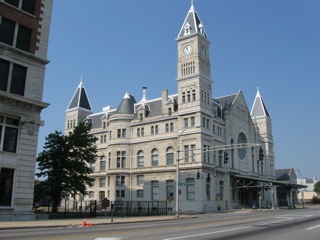 Louisville Union Station
Louisville Union Station
|
The Homeward Leg
Following our morning tour of the Louisville Slugger
Museum and drive past Union Station, we drove southward to Mammoth Cave
National Park. This park offers a variety of walking tours of the complex
underground cave system which includes 367 miles of passageways that reach
as deep as 105 feet below the surface. Refreshing cool air can be
felt several feet before one reaches one of the cave entrances as the subterranean
temperature is a fairly constant 54 degrees.
After our visit to Mammoth Cave, we motored south
to an outskirt of Chattanooga, TN where we spent the night at Homewood Suites.
This pleasantly decorated hotel contains spacious suites and is convenient
to many chain restaurants. One of our favorites, Sticky Fingers
BBQ, was just across the interstate from our hotel and we enjoyed the
final dinner of our journey. The next morning we made a smooth 6
hour drive home to Florida where we would anticipate our next rail travels.

Mammoth Cave
|

Homewood Suites, Chattanooga, TN
|


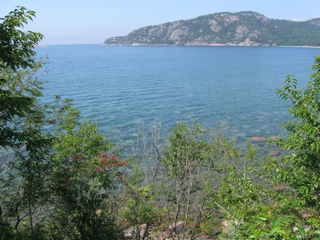
 Highway 17 crosses one of many rivers along the route
to White River
Highway 17 crosses one of many rivers along the route
to White River

 White River Motel offers clean comfortable lodging
and courtesy transportation to the VIA Rail Canada station
White River Motel offers clean comfortable lodging
and courtesy transportation to the VIA Rail Canada station



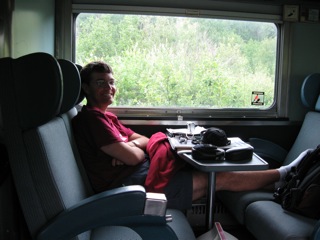
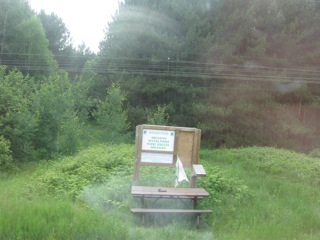
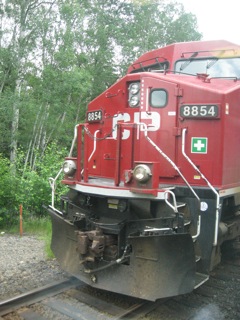
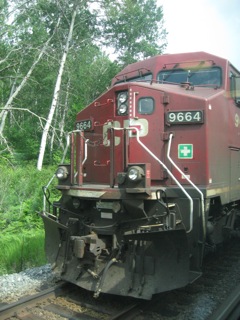
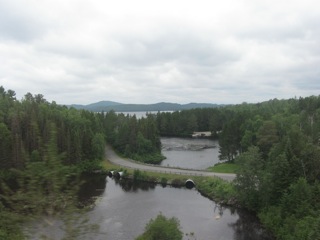 Approaching Sudbury
Approaching Sudbury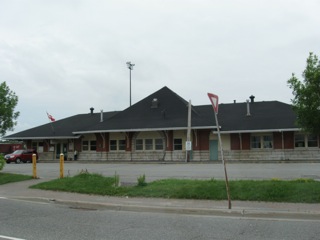 The railway depot at Sudbury
The railway depot at Sudbury





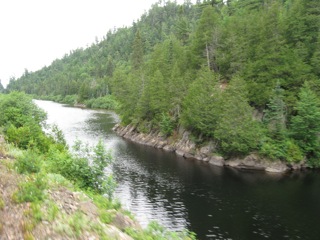
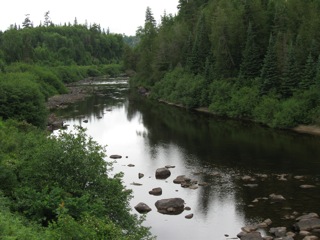
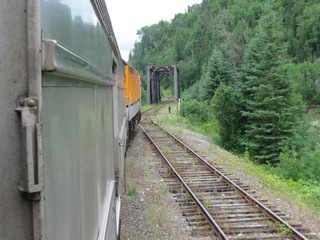
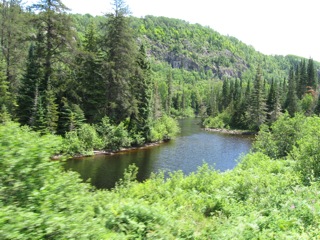
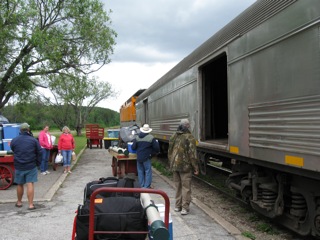
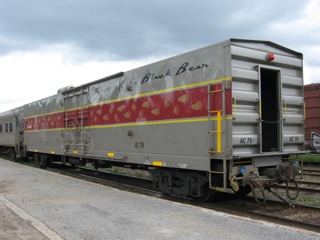








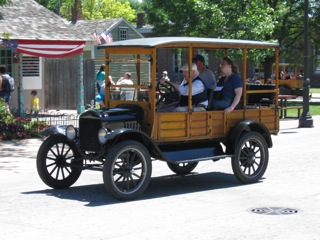 Greenfield Village, Dearborn, Michigan
Greenfield Village, Dearborn, Michigan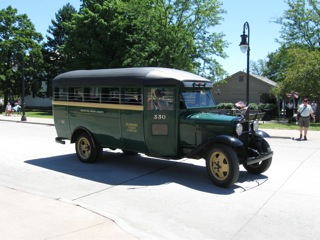 Greenfield Village, Dearborn, Michigan
Greenfield Village, Dearborn, Michigan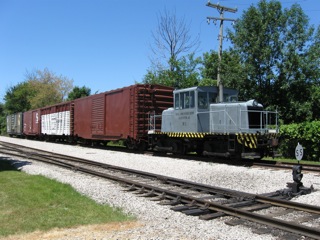 Greenfield Village, Dearborn, Michigan
Greenfield Village, Dearborn, Michigan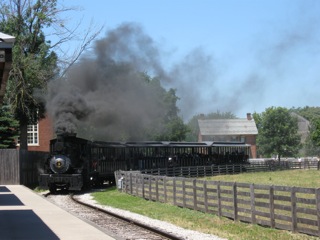 The steam train approaches the station at Greenfield
Village
The steam train approaches the station at Greenfield
Village